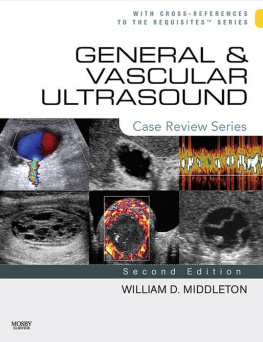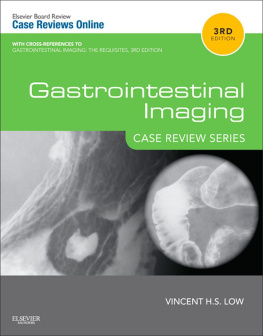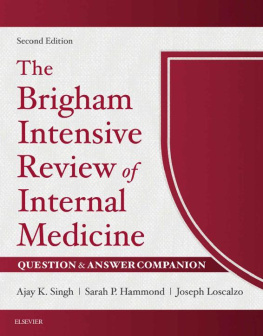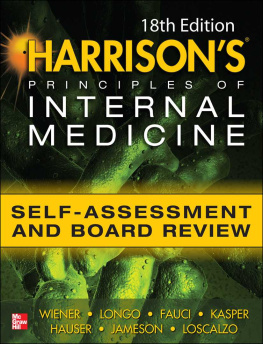Nuclear Medicine
CASE REVIEW
Series Editor
David M. Yousem, MD, MBA
Director of Neuroradiology and Professor of Radiology
Vice Chairman of Program Development
Russell H. Morgan Department of Radiology and Radiological Science
Johns Hopkins Medical Institution
Baltimore, Maryland
Other Volumes in the CASE REVIEW Series
Brain Imaging
Breast Imaging
Cardiac Imaging
Emergency Radiology
Gastrointestinal Imaging, Second Edition
General and Vascular Ultrasound, Second Edition
Genitourinary Imaging, Second Edition
Head and Neck Imaging, Third Edition
Musculoskeletal Imaging, Second Edition
Obstetric and Gynecologic Ultrasound, Second Edition
Pediatric Imaging
Spine Imaging, Second Edition
Thoracic Imaging
Vascular and Interventional Imaging
Nuclear Medicine
CASE REVIEW
SECOND EDITION
Harvey A. Ziessman, MD
Professor of Radiology
Director of Nuclear Medicine Imaging
Division of Nuclear Medicine
Russell H. Morgan Department of Radiology and Radiological Sciences
The Johns Hopkins University
Baltimore, Maryland
Patrice Rehm, MD
Associate Professor of Radiology
Director of Nuclear Medicine
University of Virginia Health Science Center
Charlottesville, Virginia
Associate Editors
Twyla B. Bartel, DO, MBA
Assistant Professor of Radiology
PET Director, Chief of Nuclear Medicine Imaging
University of Arkansas for Medical Sciences
Little Rock, Arkansas
Tracy L.Y. Brown, MD, PhD
Assistant Professor of Radiology
Program Director of Nuclear Medicine Residency
University of Arkansas for Medical Sciences
Little Rock, Arkansas
CASE REVIEW SERIES


1600 John F. Kennedy Boulevard
Suite 1800
Philadelphia, PA 19103-2899
NUCLEAR MEDICINE: CASE REVIEW, SECOND EDITION ISBN: 978-0-323-05308-2
Copyright 2011, 2002 by Mosby, Inc., an affiliate of Elsevier Inc.
All rights reserved. No part of this publication may be reproduced or transmitted in any form or by any means, electronic or mechanical, including photocopying, recording, or any information storage and retrieval system, without permission in writing from the Publisher. Details on how to seek permission, further information about the Publishers permissions policies and our arrangements with organizations such as the Copyright Clearance Center and the Copyright Licensing Agency, can be found at our website: www.elsevier.com/permissions.
This book and the individual contributions contained in it are protected under copyright by the Publisher (other than as may be noted herein).
Notices
Knowledge and best practice in this field are constantly changing. As new research and experience broaden our understanding, changes in research methods, professional practices, or medical treatment may become necessary.
Practitioners and researchers must always rely on their own experience and knowledge in evaluating and using any information, methods, compounds, or experiments described herein. In using such information or methods they should be mindful of their own safety and the safety of others, including parties for whom they have a professional responsibility.
With respect to any drug or pharmaceutical products identified, readers are advised to check the most current information provided (i) on procedures featured or (ii) by the manufacturer of each product to be administered, to verify the recommended dose or formula, the method and duration of administration, and contraindications. It is the responsibility of practitioners, relying on their own experience and knowledge of their patients, to make diagnoses, to determine dosages and the best treatment for each individual patient, and to take all appropriate safety precautions.
To the fullest extent of the law, neither the Publisher nor the authors, contributors, or editors, assume any liability for any injury and/or damage to persons or property as a matter of products liability, negligence or otherwise, or from any use or operation of any methods, products, instructions, or ideas contained in the material herein.
Previous edition copyrighted 2001.
International Standard Book Number: 978-0-323-05308-2
Acquisitions Editor: Rebecca Gaertner
Publishing Services Manager: Pat Joiner-Myers
Project Manager: Marlene Weeks
Designer: Steven Stave

To Karen and Bob
Series Foreword
In the last decade, no field has made more monumental clinical strides in radiology than nuclear medicine. The explosion of PET/CT scanners has been instrumental in retooling how oncologic specialists decide who receives therapy, how that therapy is affecting the patient, whether to continue treatment, and if there is evidence of residual or recurrent disease. As a head and neck radiology aficionado, I see these cases frequently in the clinic and admire the value of the functional FDG PET component of the study. Similar advances in cardiac imaging, sestamibi scanning for parathyroid adenomas, and molecular imaging have had a great impact in medicine.
The second edition of Nuclear Medicine: Case Review by Drs. Ziessman, Rehm, Bartel, and Brown builds on the success of the first edition. It brings the reader up to date with the advances in technology as it supplies 200 excellent quality cases with poignant questions and discussions. The authorship team has been successful in maintaining a balance of nuclear medicine physics, radiation safety information, and clinically based material to produce a valuable Case Review Series book for trainees and practitioners in nuclear medicine. The style of the Case Review Series continues to be the best means to learn material in an interactive fashion with selected images, provocative questions, short answers, great discussions, pertinent references, and links back to Nuclear Medicine: THE REQUISITES for those who prefer more didactic textual material.
Congratulations to Drs. Ziessman, Rehm, Bartel, and Brown for furthering the success of Nuclear Medicine: Case Review with their exceptional second edition.
David M. Yousem, MD, MBA
Preface
The second edition of Nuclear Medicine: Case Review builds on the successful first edition and emphasizes the many advances that have taken place since its publication in 2002. This new edition extensively updates the case study material to reflect these advances and encompasses the current practice of nuclear medicine. We have two new associate editors, Drs. Twyla Bartel and Tracy Brown from the University of Arkansas, who contributed many excellent cases for this new edition. It has been a challenge to limit the number of cases to 200 because we had so much good new material, but I think we have succeeded in selecting the best. Much of the material is completely new, particularly the cases on PET/CT, SPECT/CT, and radiation safety. With the first edition, F-18 FDG PET was just beginning to become a clinical imaging modality after decades of investigation and development. It was primarily indicated for oncologic imaging. FDG PET was a major advance and changed the practice of oncology and nuclear imaging. Since then, hybrid PET/CT instruments became commercially available and their clinical use grew at a rapid rate, becoming the standard PET imaging modality. FDG PET/CT is now routinely reimbursed for many different oncologic indications and increasingly for neurologic and cardiac indications. Cardiac stress imaging using rubidium-82 PET is now used at many imaging centers because of its excellent image quality. Because it is generator produced, an on-site cyclotron is not needed. Cardiac viability imaging with F-18 FDG and Rb-82 is also increasing. Brain PET/CT is growing and expected soon to achieve its long-anticipated clinical utility, particularly for Alzheimers disease, epilepsy, and Parkinsons disease. The great success of PET/CT led to the introduction of hybrid SPECT/CT for single photon imaging (e.g., somatostatin receptor imaging, I-123 MIBG, Tc-99m sestamibi parathyroid imaging, infection imaging). SPECT/CT is now showing the rapid clinical growth shown previously by PET/CT. Both hybrid technologies are leading us into the future of molecular imaging. Radiation safety, long an important topic but not emphasized in the first edition, is discussed in many cases presented in the second edition. Any case study retained from the first edition continues to prove its clinical importance and has been updated to reflect current practice. We think that the second edition will surpass the success of the first edition.
Next page













